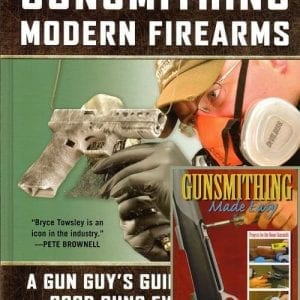This is an excerpt from my new book, “Prepper Guns” due out this spring.
I first ran into this new pistol when I was in Bessemer, Alabama in April of 2014 for the grand opening of Steyr’s new U.S. based facility.
At first I thought it was “just another Glock clone.” Then we shot some early production models of the gun in their indoor range and I discovered it was a lot more than that. This gun has a few unique and innovative features. I was impressed and intrigued enough with the handgun that I ordered one of my own before I left. It took a while to get it as they were ramping up production, but late in the year it arrived.
The L-A1 is a full size, duty-style, double-stack, striker-fired, polymer-frame handgun. The gun is available in .40 S&W, .357 Sig and 9mm. Mine is a 9mm. That means the metal magazine holds 17 cartridges. The .40 S&W and .357 Sig versions will hold 12 cartridges. I am not sure why there is this discrepancy, as the magazines should easily hold 15, but that’s what the web site says. I confirmed it with a company representative who also didn’t know why. The gun will fire without the magazine inserted, which is important in a self-defense handgun.
The gun has a 4.52-inch barrel and is not particularly heavy at 28.8 ounces. It’s 7.9 inches long, 5.1 inches high and 1.2 inches wide.
The handgun has a massive slide that is big and square in the European style. That helps control recoil with the mass and weight. The grip is square and boxy in the back, with finger grips in the front. It is a great fit for my hand and is very comfortable under recoil. It also lets you get your hand up high and close to the axis of the bore so, again, recoil is mitigated and controlled.
The trigger has a center-lever safety (like a Glock.) The trigger points down, at close to 90 degrees to the bore axis, rather than angling forward as with some other striker-fired guns. Although the distance from where the web of the hand contacts the backstrap to the trigger is 2.9 inches, which is consistent with Glock and perhaps other handguns, this design makes it feel like the trigger is easier to reach. The trigger doesn’t “rock” on the axis as much as you pull it, making the feel much different and more like a conventional trigger. This is one of the features that I really like. I have wide hands with stubby, Irish fingers. Most striker-fired handguns put the trigger far forward on the gun and they just don’t feel right for me. This gun puts the trigger so it feels like my finger is pulling it correctly. I point this out so that other shooters who have trouble with striker-fired trigger position might want to take a look at this gun. The trigger has a short travel for a striker-fired handgun, with a total travel of 0.2-inch. The two stage trigger divides exactly in half. The first stage travels one-tenth and the second stage is one-tenth of an inch of travel. The reset is at the center point, one-tenth inch back. The total pull weight for the trigger on my gun is 5 pounds, ten ounces. The first stage is one pound, nine ounces, so the second stage is just over four pounds. The trigger breaks clean and crisp for a striker-fired gun.
The trigger guard is large and is actually larger in front, so it allows the use of gloves. There is a rail on the bottom of the frame for mounting accessories like a light or laser.
The gun has the slide release and the magazine release both on the left side for right handed shooters. As a lefty I am used to that, and use my index finger to run both the mag release and the slide release when I use it. The truth is I rarely use a slide release when shooting, preferring instead to rack the slide with my weak (right) side hand. However, I can easily manipulate the slide release with my finger.
The loaded chamber indicator sits flush in the rear of the slide when the chamber is empty and is raised slightly when the chamber is loaded. This allows the shooter to check both visually and by feel for a loaded chamber.
The takedown lever is on the right side of the gun. There is a lock on the side that can be activated with either of the two keys provided that will lock out the gun and prevent it from being used.
Perhaps the most unique features of this pistol are the sights. The front sight is a triangle with a white, triangle insert. The rear sight is a trapezoid with two white trapezoidal inserts, one on each side. Both sights are in dovetails so they can be drifted for windage adjustment. There is no elevation adjustment. It takes a little getting used to, but once you understand the sights and train your eyes and mind not to be surprised when they appear on the target, this system works surprisingly well.
I used this pistol to do a lot of speed drills on paper and with my MGM plate rack. The first few times I presented from the holster these odd sights threw me a bit of a curve, but within just a few minutes of practice I could draw and shoot amazingly fast. Target to target transitions were also very fast. These sights inspire a “what the hell” reaction when you first see them, but after shooting a little you start to get a warm and fuzzy feeling about them.
But if you are one of those guys who hates anything different and if you just can’t stand change, there are optional traditional sights.
I have a few hundred rounds through the gun so far and it’s been very reliable. Of course, I would expect that from this company as they have been building guns for very long time and have an excellent reputation for reliability.
The gun comes with a spare magazine, a lockable case, two keys and of course, the Clinton-inspired and required padlock.
One great feature is the price. The MSRP is only $560.00. That should put the street price below $500.00.







